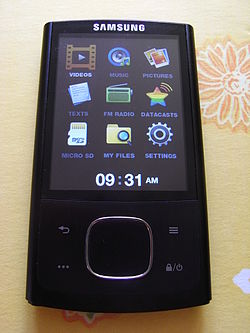The Nomad was a range of digital audio players designed and sold by Creative Technology Limited, and later discontinued in 2004. Subsequent players now fall exclusively under the MuVo and ZEN brands.

Rockbox is a free and open-source software replacement for the OEM firmware in various forms of digital audio players (DAPs) with an original kernel. It offers an alternative to the player's operating system, in many cases without removing the original firmware, which provides a plug-in architecture for adding various enhancements and functions. Enhancements include personal digital assistant (PDA) functions, applications, utilities, and games. Rockbox can also retrofit video playback functions on players first released in mid-2000. Rockbox includes a voice-driven user-interface suitable for operation by visually impaired users.

iPodLinux is a μClinux-based Linux distribution designed specifically to run on Apple Inc.'s iPod. When the iPodLinux kernel is booted it takes the place of Apple's iPod operating system and automatically loads Podzilla, an alternative GUI and launcher for a number of additional included programs such as a video player, an image viewer, a command line shell, games, emulators for video game consoles, programming demos, and other experimental or occasionally unfinished software.
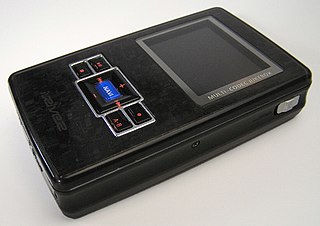
The iRiver H300 series are a series of portable audio players developed by iRiver, made up of the iRiver H320 and H340 models. They were first announced on September 22, 2004 replacing the H100/iHP-100. Each can play music, transfer pictures directly from digital cameras and UMS-compatible devices, such as flash drives, and display digital images on a colour screen. In the United States, the H320 initially retailed for $329 and the H340 was $429.
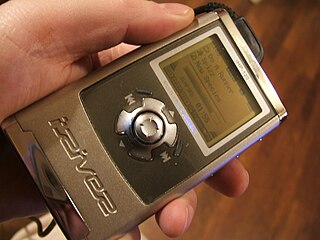
The iRiver H100 series is a series of discontinued portable digital audio players (DAP) made by iriver and originally released in October 2003. The models in the H100 series differ mainly in hard drive storage capacity. The players were succeeded by the iriver H300 series.

Yepp was Samsung Electronics' digital audio player brand until Samsung decided to retire most of their family brands in February 2011. From then on, their MP3 players were simply branded "Samsung" worldwide until they discontinued all of them in late 2013. The brand included a wide range of hard-drive based as well as flash-memory based players. The name is claimed to be an acronym for "young, energetic, passionate person".

The RioForge is a digital audio player that was produced by Rio Audio, Inc. While it competed in the same market as Apple Inc's iPod mini, it is considerably different as it plays from internal memory, SD card, or FM broadcast and runs on a single AAA battery.
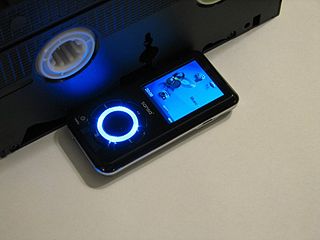
The Sansa e200 series is a portable media player developed by SanDisk and released on January 5, 2006. The device is available in four capacities of Flash memory: 2 GB (e250), 4 GB (e260), 6 GB (e270), and 8 GB (e280). All players have a 1.8-inch, TFT LCD display with a resolution of 176 by 220 pixels. Certain files, if not in a format accepted by the player's original firmware, must first be converted with the Sansa Media Converter Windows software. This will convert images to bitmap format (.bmp) and videos to MJPEG, for v1 models. On v2 players it will convert videos to DivX and simply resize images. It is not possible to simply copy videos to the device, even if they seem to be in the correct format; trying to access them displays an error message.

SanDisk has produced a number of flash memory-based digital audio and portable media players since 2005. The current range of products bears the SanDisk Clip name. SanDisk players were formerly marketed under the Sansa name until 2014.

The Archos Jukebox is a series of Archos portable audio players from 2000 to 2002.
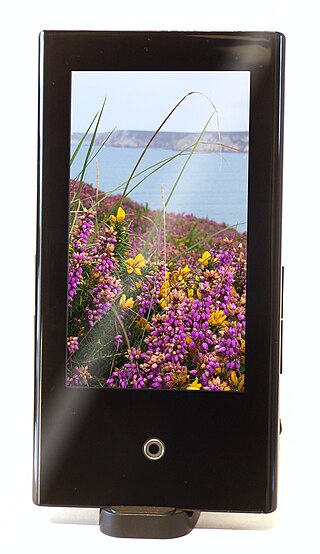
The Samsung YP-P2 is a flash memory-based Yepp portable media player produced and developed by Samsung Electronics.

The Nokia N96 is a discontinued high-end mobile phone announced by Nokia on 11 February 2008 at the Mobile World Congress in Barcelona as part of the Nseries line. The N96 runs Symbian OS v9.3. It is compatible with the N-Gage 2.0 gaming platform and has a DVB-H TV tuner and AV output.

The Sansa Fuze is a portable media player developed by SanDisk and released on March 8, 2008. The Fuze is available in three different Flash memory capacities: 2 GB, 4 GB, and 8 GB and comes in six different colors: black, blue, pink, red, silver, and white. Storage is expandable via a microSDHC slot with capacity up to 32 GB, and unofficially to 64 GB or more via FAT32 formatted SDXC cards. All models have a 1.9 inch TFT LCD display with a resolution of 220 by 176 pixels and a built-in monaural microphone and FM tuner; recordings of the latter two are saved as PCM WAV files.

The Dingoo is a handheld gaming console that supports music and video playback and open game development. The system features an on-board radio and recording program. It was sold to consumers in three colors: white, black, and pink. It was released in February 2009 and had sold over 1 million units.
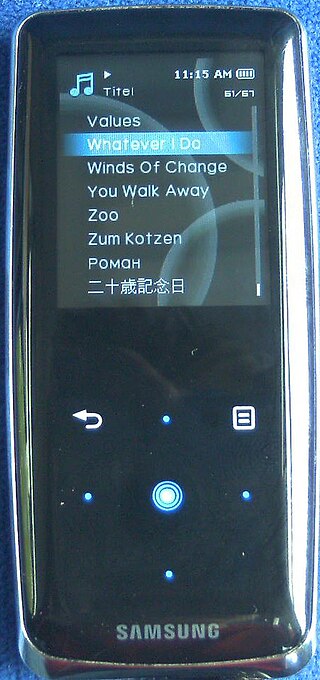
The Samsung YP-S3 is an MP3 player produced and manufactured by Samsung Electronics released in 2008.
The French consumer electronics company Archos manufactured a number of products which have since been discontinued.

The Sansa c200 series is a line of portable media players developed by SanDisk. The line consists of two models: the c240, 1 GB, the c250, 2 GB. Both models feature a microSD card slot, a 1.4-inch LCD display, a built-in microphone, and an FM radio. c200 series players are available in four colors: black, red, pink, and blue.
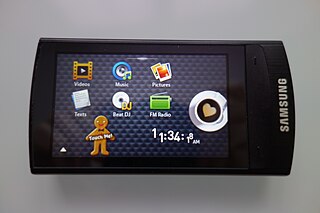
The Samsung YP-R1 is a portable media player made by Samsung, first leaked on the webshop play.com on June 14, 2009 and then released at the end of September 2009. It was developed along with the YP-R0 with which it shares several specifications . The R1 is available in four different Flash memory capacities: 4 GB, 8 GB, 16 GB and 32 GB. It comes in three different colors: black, silver and pink. It features an aluminum case, a 2.6 inch TFT LCD capacitive touchscreen with a resolution of 240 by 400 pixels, a RDS FM tuner, bluetooth and a proprietary USB connector. Several EQ and sound effects are available through Samsung's DNSe 3.0 sound engine.
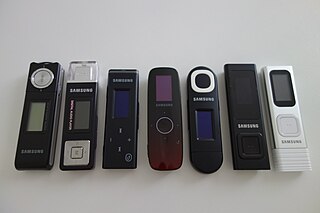
The Samsung Yepp U series is a line of USB key MP3 players made by Samsung and introduced in 2005 with the YP-U1. Samsung used to release a new device every year. Only the YP-U7 was released two years after the U6. It is the largest and most durable Yepp series. The most famous competitor is the Sony Walkman B series. In South Korea, the iRiver T series is also a main competitor.
